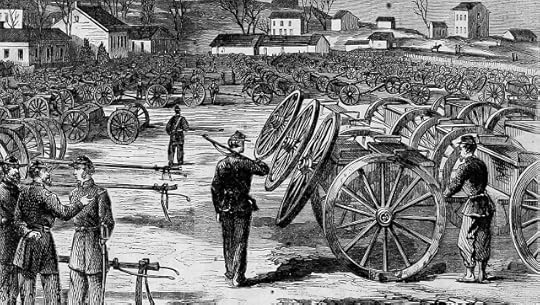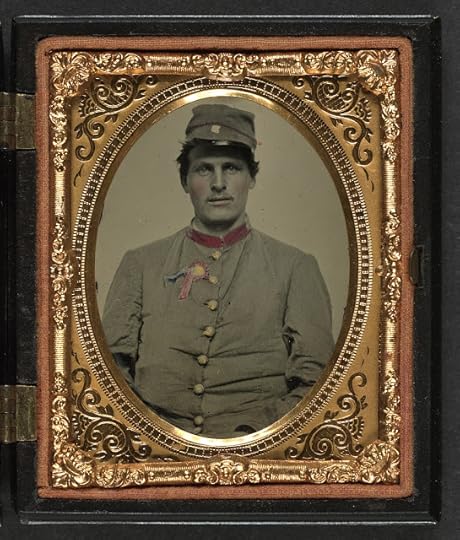With the Pointe Coupee Battery at Nashville
Scramblingback to the Pointe Coupee Battery’s position after spying the advancingFederals closing in on them, Rene A. de Russy recalled the thrilling finalmoments before the battery was overrun on December 16, 1864, during the Battleof Nashville.
“The battery suffered severely, men and horses going down inthe turmoil, a caisson being blown to atoms and Edgar Gueson being cut in by ashell. Still, the battery held fast, even when the men to the left had brokenand when the Union men came around the hill on the flank. Gun after gun wasserved until human endurance could go no further. Then with aparting shot into the very faces of Thomas’s men, Corporal Joseph H. Vienne andhis fellows started back under orders from Captain Alcide Bouanchaud. CorporalVautier trained his gun upon Vienne’s captured piece but without avail and theorder came to withdraw, several of the pieces first being spiked. The membersof the battery then made for the Granny White Pike, leaving over 20 dead andwounded within less than 100 yards of their guns. From that time on, theretreat partook the nature of a route and “suave qui pent” was the watchword.”
De Russy’s account of the second dayof the Battle of Nashville first saw publication in the May 20, 1907, editionof the New Orleans Times-Democrat. The battery was part of Myrick’sArtillery Battalion which was attached to General William Loring’s division ofGeneral A.P. Stewart’s Corps.
 The spoils of war: the four 12-pdr Napoleons of the Pointe Coupee Battery are somewhere amidst this field of captured cannons and caissons gathered at General George H. Thomas's headquarters in Nashville in the days after the battle.
The spoils of war: the four 12-pdr Napoleons of the Pointe Coupee Battery are somewhere amidst this field of captured cannons and caissons gathered at General George H. Thomas's headquarters in Nashville in the days after the battle. At the opening of the second day’shostilities on December 16, 1864, the new line of the Confederates was locatedsome distance to the left of the Granny White Pike near the base of a high hillwith a running range of rock fence making a breastworks about four feet inheight and a range of trees skirting near the pike. The Pointe Coupee Batterywas the last battery near the base of the hill.
The Federal troops were extremelyactive and at times precipitated an onslaught which required a check from thebattery, driving the Union forces to shelter. Shortly before noon the rattle ofmusketry and the roar of half a hundred pieces of artillery gave notice thatthe Confederates on the right were engaged in a terrible battle and great wasthe suspense in the battery while awaiting news as to whether the tide ofbattle was running for or against the army. Could the old Army of Tennessee,with its thinned line, hold its own and gain further renown? This was thequestion that each man asked the other and the tension told on the nerves ofmany.
For three or four hours the battleraged and then came detachments of cavalry riding by, bringing the news thatthe day had been won for the Confederates and that Lee’s Corps had drivenThomas back in disorder and defeat. Thus encouraged, the Pointe Coupee Batterybraced itself with the rest of the wing for the general attack contemplated onthe front by the Union troops and awaited the onslaught of the seriedthousands.
In close marching columns the Federalscame forward, first opening on the Confederate skirmish lines and works withhalf a dozen batteries. On they came at the double quick for the Confederatebreastworks as the left wing of the Army of Tennessee braced to receive them.Out burst the blaze of the Confederate guns and the Federals paused in theirprogress and for a moment sought shelter, finding this cover behind a range ofhills which ran parallel with the Confederate lines.
Our battery was prominent in therepulse and performed its full share of the deeds of glory in the briefinterchange while General [William] Loring, but a short space distant, cheeredand waved his hat in encouragement. Noting that the Union forces had made anoblique move in their charge, the battery at once grasped the opportunitypresented and sent in heavy charges of grape with such telling effect that theright of the brigade was thrown into disorder and broke for cover with greatlythinned ranks.
 A proud Confederate artilleryman wearing a secession cockade.
A proud Confederate artilleryman wearing a secession cockade. Foiled in his first attempt, Thomaspaused and pondered, appreciating that direct attack was futile, and aretrograde movement took place with his forces. Taking advantage of the lull, Iclimbed a hill with some comrades intending to get a bird’s eye view of thesituation but was somewhat discouraged by the advent of a reckless shell whichdropped carelessly in my vicinity and dug a large hole in the hilltop. Beforewe could turn and flee, however, a second shell followed and decapitated ayoung Confederate, and warned the survivors that their range had been found bythe enemy.
Notwithstanding the shock of thisoccurrence, I with a friend from the battery threw ourselves on the ground andsquirmed to the edge of the hill where a view of over a mile stretched beforeus. Here we could see the moves and counter-moves of Thomas’s forces and theaddition of two batteries to the artillery gave us the realization that adesperate encounter was coming. Hardly had we rejoined our battery when GeneralHood rode up to General Loring and said, “General, if we can hold our line forhalf an hour or better, the victory will be ours.” His face was aglow with thebeam of hope and his eyes flashed with the fire of conflict; General Hoodpresented an inspiring sight to his soldiers and the Pointe Coupee Batterycheered him to the echo.
Then came the attack as Thomas’s armymoved onward. But, stubborn as was the onslaught, equally determined was thedefense and for hours the battle raged with blood flowing like water. Thebattery suffered severely, men and horses going down in the turmoil, a caissonbeing blown to atoms and Edgar Gueson being cut in by a shell. Still, thebattery held fast, even when the men to the left had broken and when the Unionmen came around the hill on the flank. Gun after gun was served until humanendurance could go no further.
Then with a parting shot into the very faces of Thomas’s men,Corporal Joseph H. Vienne and his fellows started back under orders from CaptainAlcide Bouanchaud. Corporal Vautier trained his gun upon Vienne’s capturedpiece but without avail and the order came to withdraw, several of the piecesfirst being spiked. The members of the battery then made for the Granny WhitePike, leaving over 20 dead and wounded within less than 100 yards of theirguns. From that time on, the retreat partook the nature of a route and “suavequi pent” was the watchword. That the defeat was a more bitter disappointmentto General Hood than the retreat at Moscow was to Bonaparte was the feelingwhich prevailed throughout the army. But the Pointe Coupee had fought the goodfight and had been faithful unto death.
To read more about the Battle of Nashville, please check out these posts:
The "Glory" Business: The 7th Minnesota at Nashville
William Keesy and the Battle of Nashville
A Carnival of Death: A Federal Officer's View of the Battle of Nashville (99th Ohio)The Troops Need Rest Very Much: A Confederate Reporter Writes After Nashville
Grab a Root! With the 111th Ohio at Nashville
Source:
“Record ofthe Pointe Coupee Battery in the Fierce Battle of Nashville,” Rene Amedee de Russy, New Orleans Time-Democrat (Louisiana), May 20, 1907, pg. 5
Daniel A. Masters's Blog
- Daniel A. Masters's profile
- 1 follower



